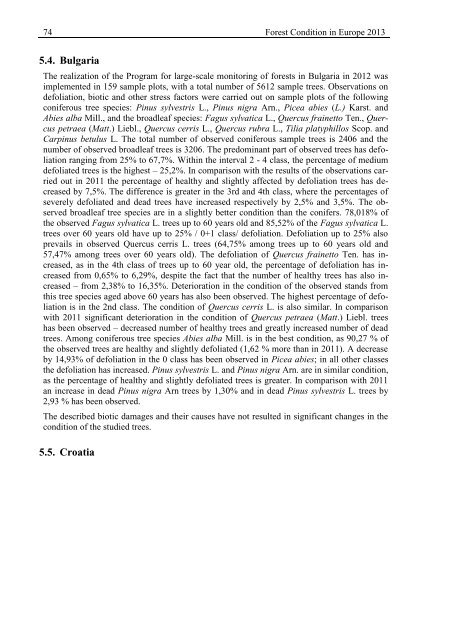Forest Condition in Europe - ICP Forests
Forest Condition in Europe - ICP Forests
Forest Condition in Europe - ICP Forests
You also want an ePaper? Increase the reach of your titles
YUMPU automatically turns print PDFs into web optimized ePapers that Google loves.
74 <strong>Forest</strong> <strong>Condition</strong> <strong>in</strong> <strong>Europe</strong> 2013<br />
5.4. Bulgaria<br />
The realization of the Program for large-scale monitor<strong>in</strong>g of forests <strong>in</strong> Bulgaria <strong>in</strong> 2012 was<br />
implemented <strong>in</strong> 159 sample plots, with a total number of 5612 sample trees. Observations on<br />
defoliation, biotic and other stress factors were carried out on sample plots of the follow<strong>in</strong>g<br />
coniferous tree species: P<strong>in</strong>us sylvestris L., P<strong>in</strong>us nigra Arn., Picea abies (L.) Karst. and<br />
Abies alba Mill., and the broadleaf species: Fagus sylvatica L., Quercus fra<strong>in</strong>etto Ten., Quercus<br />
petraea (Matt.) Liebl., Quercus cerris L., Quercus rubra L., Tilia platyphillos Scop. and<br />
Carp<strong>in</strong>us betulus L. The total number of observed coniferous sample trees is 2406 and the<br />
number of observed broadleaf trees is 3206. The predom<strong>in</strong>ant part of observed trees has defoliation<br />
rang<strong>in</strong>g from 25% to 67,7%. With<strong>in</strong> the <strong>in</strong>terval 2 - 4 class, the percentage of medium<br />
defoliated trees is the highest – 25,2%. In comparison with the results of the observations carried<br />
out <strong>in</strong> 2011 the percentage of healthy and slightly affected by defoliation trees has decreased<br />
by 7,5%. The difference is greater <strong>in</strong> the 3rd and 4th class, where the percentages of<br />
severely defoliated and dead trees have <strong>in</strong>creased respectively by 2,5% and 3,5%. The observed<br />
broadleaf tree species are <strong>in</strong> a slightly better condition than the conifers. 78,018% of<br />
the observed Fagus sylvatica L. trees up to 60 years old and 85,52% of the Fagus sylvatica L.<br />
trees over 60 years old have up to 25% / 0+1 class/ defoliation. Defoliation up to 25% also<br />
prevails <strong>in</strong> observed Quercus cerris L. trees (64,75% among trees up to 60 years old and<br />
57,47% among trees over 60 years old). The defoliation of Quercus fra<strong>in</strong>etto Ten. has <strong>in</strong>creased,<br />
as <strong>in</strong> the 4th class of trees up to 60 year old, the percentage of defoliation has <strong>in</strong>creased<br />
from 0,65% to 6,29%, despite the fact that the number of healthy trees has also <strong>in</strong>creased<br />
– from 2,38% to 16,35%. Deterioration <strong>in</strong> the condition of the observed stands from<br />
this tree species aged above 60 years has also been observed. The highest percentage of defoliation<br />
is <strong>in</strong> the 2nd class. The condition of Quercus cerris L. is also similar. In comparison<br />
with 2011 significant deterioration <strong>in</strong> the condition of Quercus petraea (Matt.) Liebl. trees<br />
has been observed – decreased number of healthy trees and greatly <strong>in</strong>creased number of dead<br />
trees. Among coniferous tree species Abies alba Mill. is <strong>in</strong> the best condition, as 90,27 % of<br />
the observed trees are healthy and slightly defoliated (1,62 % more than <strong>in</strong> 2011). A decrease<br />
by 14,93% of defoliation <strong>in</strong> the 0 class has been observed <strong>in</strong> Picea abies; <strong>in</strong> all other classes<br />
the defoliation has <strong>in</strong>creased. P<strong>in</strong>us sylvestris L. and P<strong>in</strong>us nigra Arn. are <strong>in</strong> similar condition,<br />
as the percentage of healthy and slightly defoliated trees is greater. In comparison with 2011<br />
an <strong>in</strong>crease <strong>in</strong> dead P<strong>in</strong>us nigra Arn trees by 1,30% and <strong>in</strong> dead P<strong>in</strong>us sylvestris L. trees by<br />
2,93 % has been observed.<br />
The described biotic damages and their causes have not resulted <strong>in</strong> significant changes <strong>in</strong> the<br />
condition of the studied trees.<br />
5.5. Croatia
















